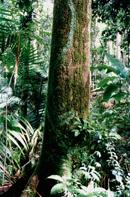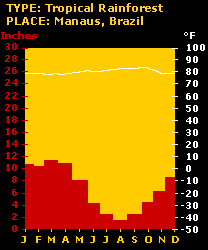|
 Tropical
Rainforest Tropical
Rainforest
The tropical rainforest is a hot, moist biome found near Earth's
equator. The world's largest tropical rainforests are in South America,
Africa, and Southeast Asia. Tropical rainforests receive from 60
to 160 inches of precipitation that is fairly evenly distributed
throughout the year. The combination of constant warmth and abundant
moisture makes the tropical rainforest a suitable environment for
many plants and animals. Tropical rainforests contain the greatest
biodiversity in the world. Over 15 million species of plants and
animals live within this biome. Photo
© Gayle W. Croft
The hot and humid conditions
make tropical rainforests an ideal environment for bacteria and
other microorganisms. Because these organisms remain active throughout
the year, they quickly decompose matter on the forest floor. In
other biomes, such as the deciduous forest, the decomposition of
leaf litter adds nutrients to the soil. But in the tropical rainforest,
plants grow so fast that they rapidly consume the nutrients from
the decomposed leaf litter. As a result, most of the nutrients are
contained in the trees and other plants rather than in the soil.
Most nutrients that are absorbed into the soil are leached out by
the abundant rainfall, which leaves the soil infertile and acidic.

Back
| Next
|











